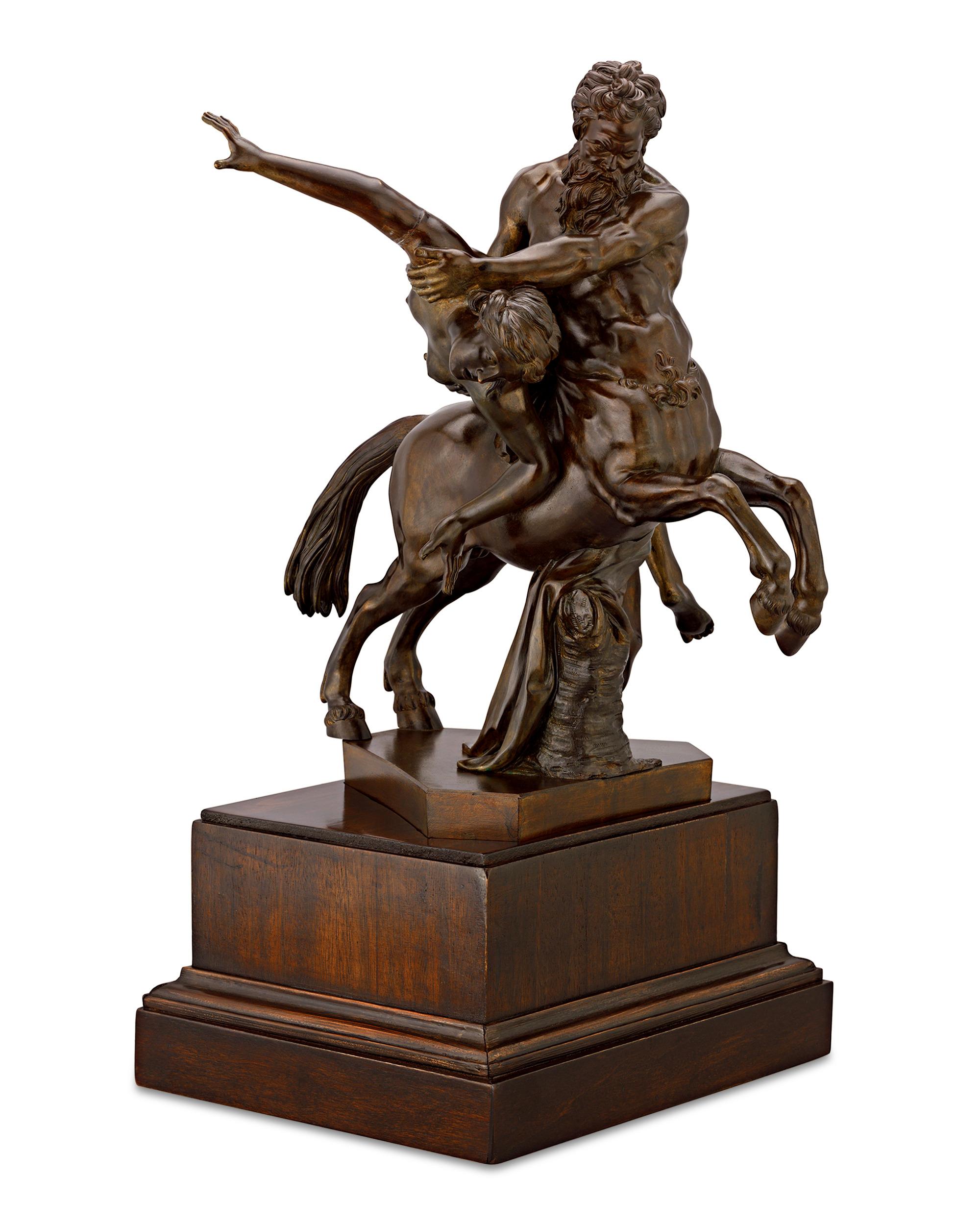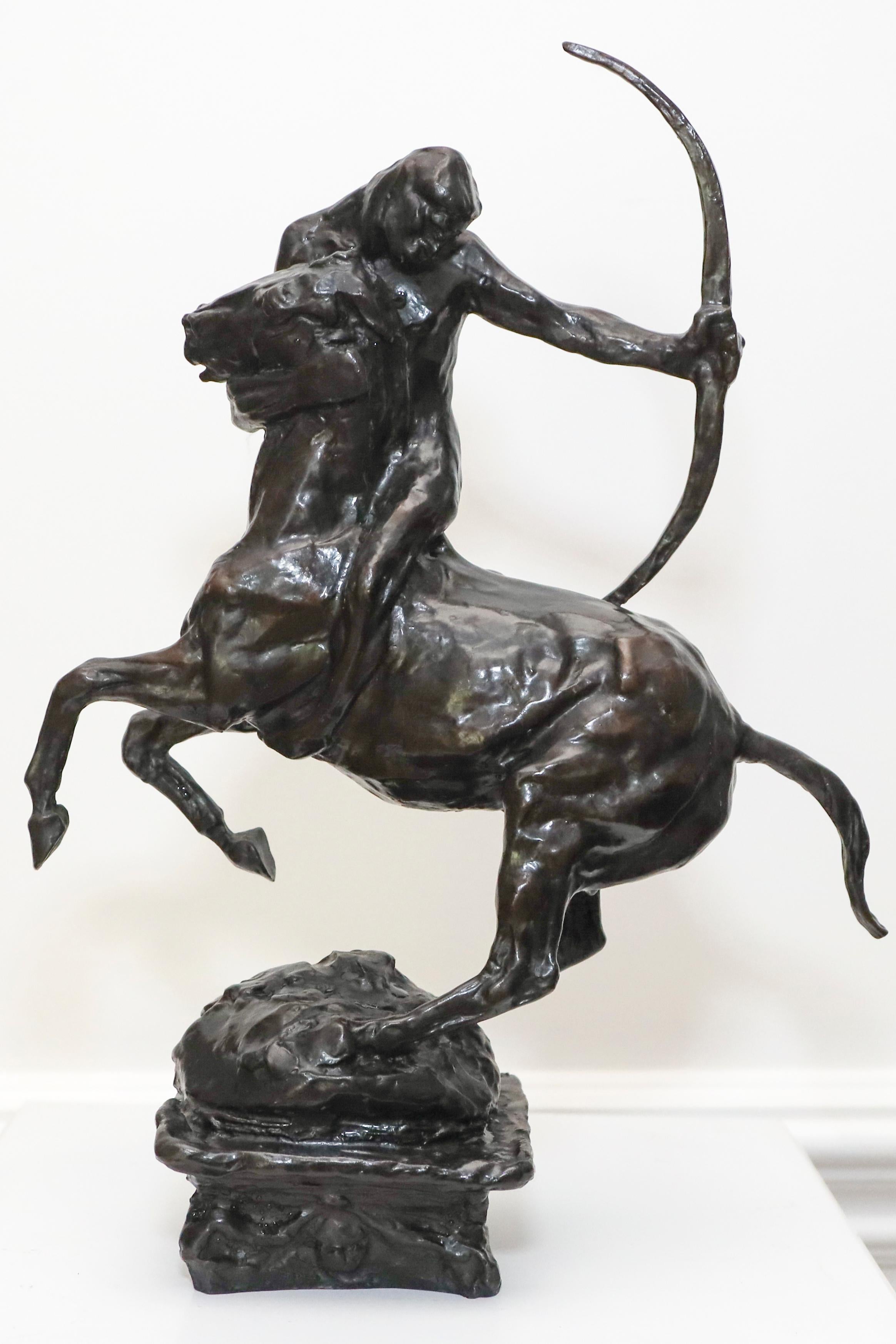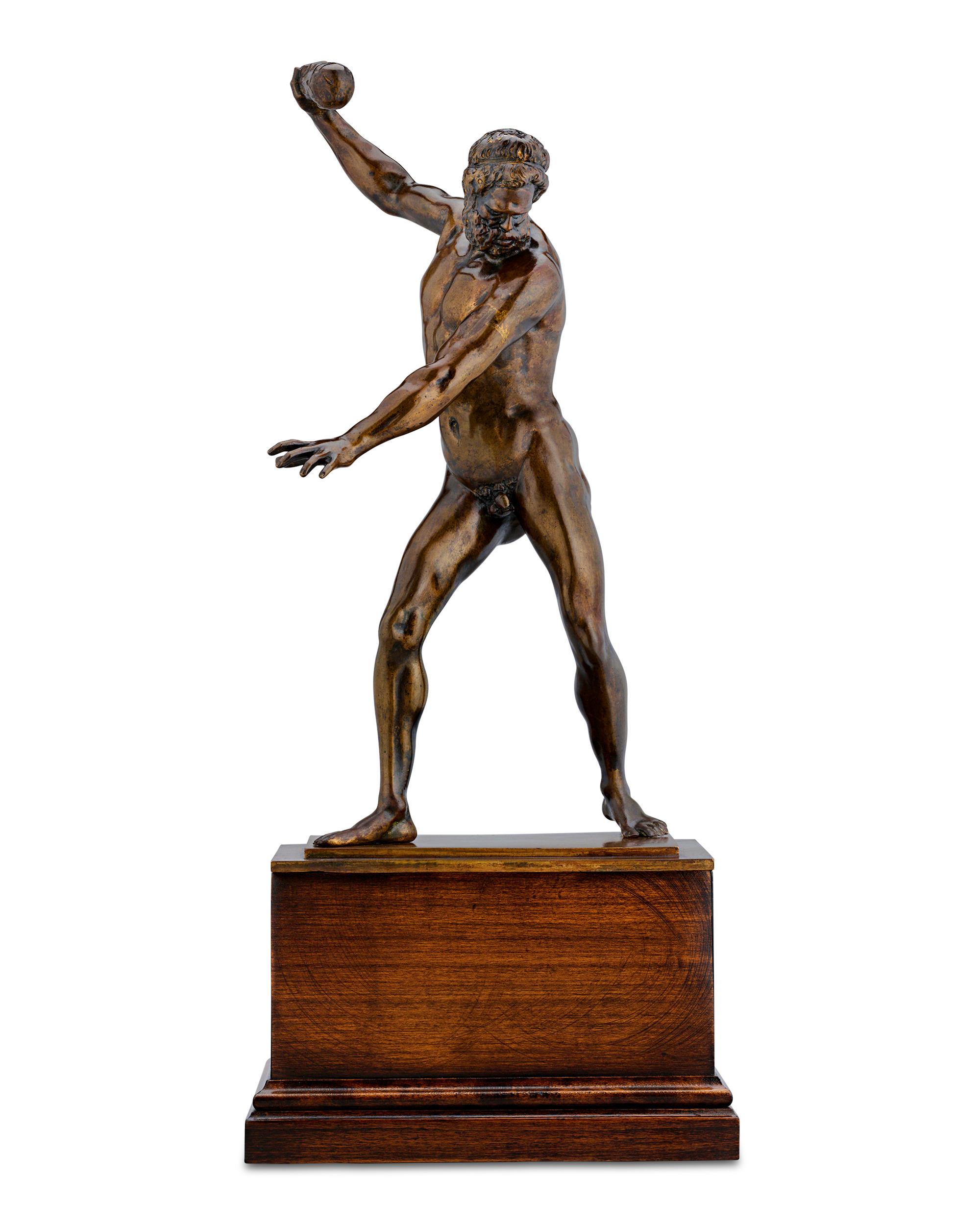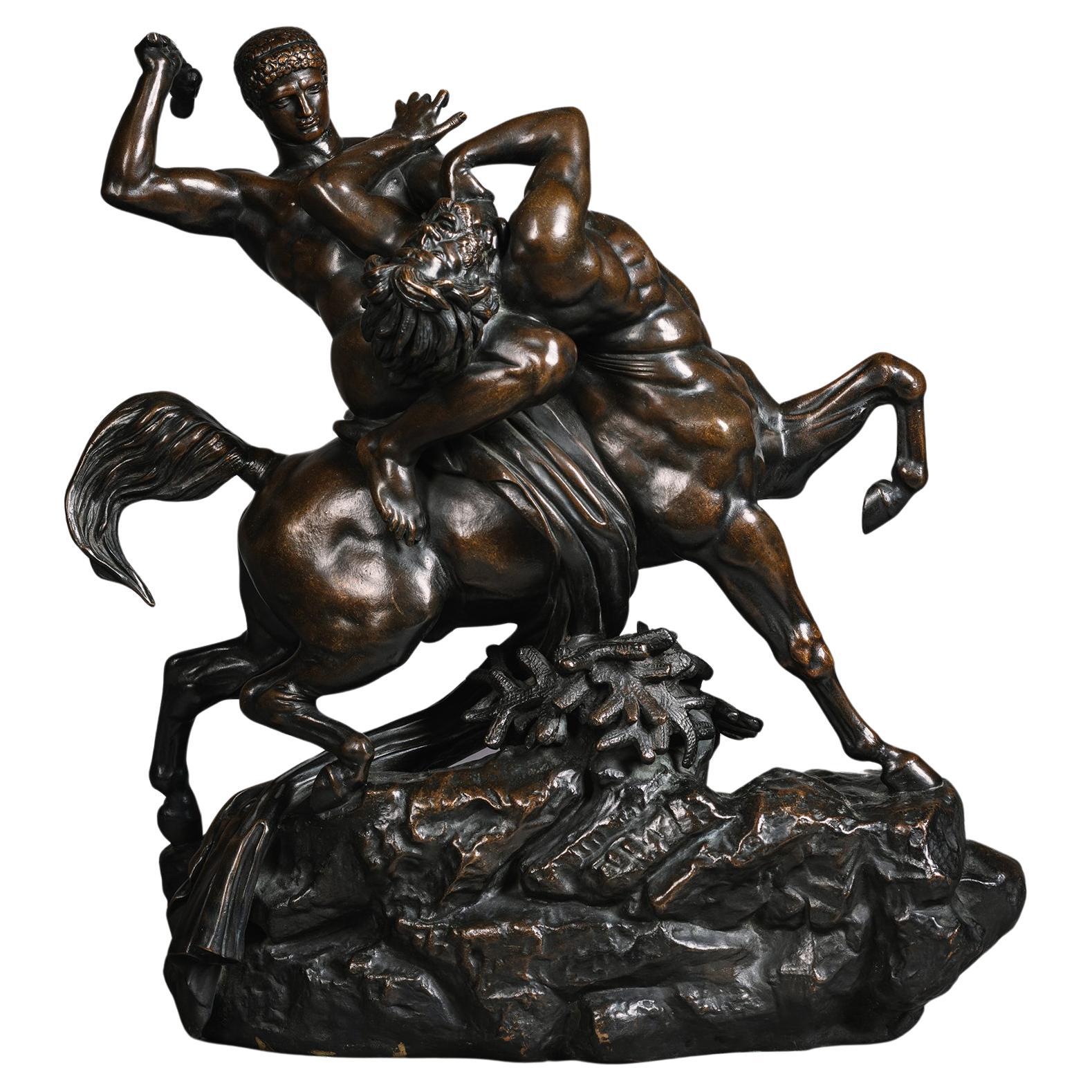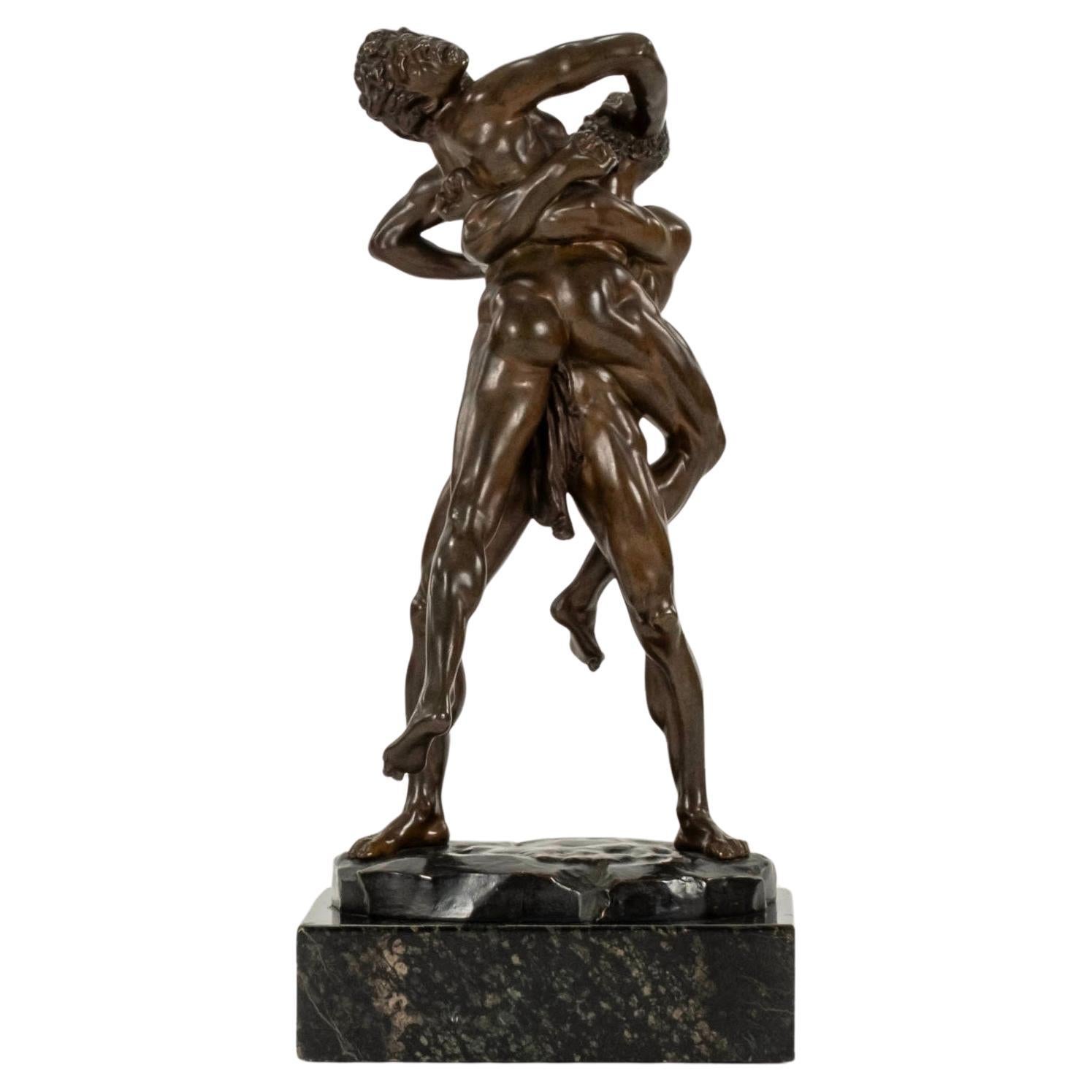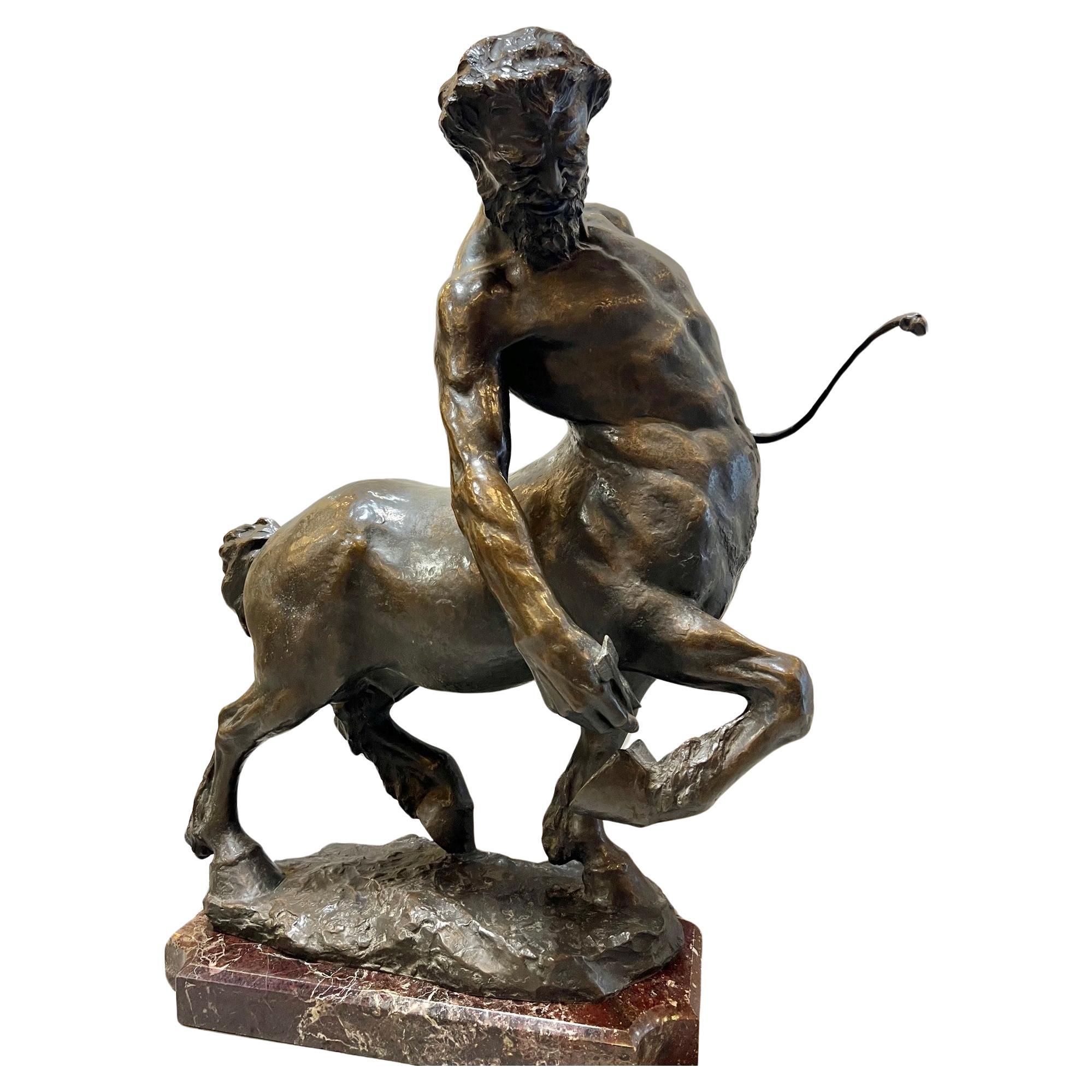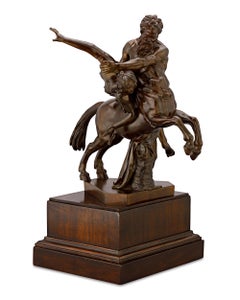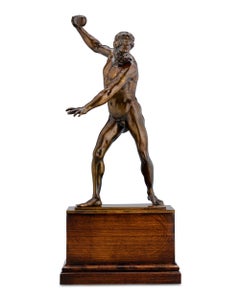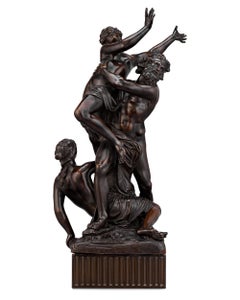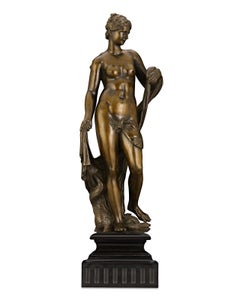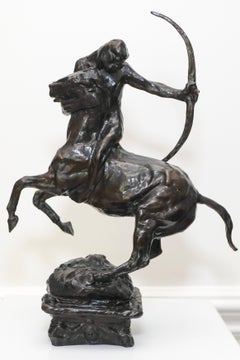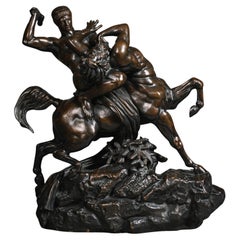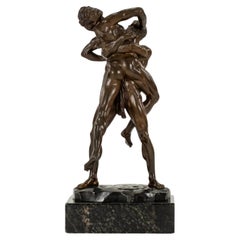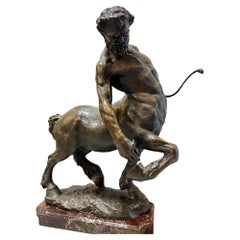Items Similar to Hercules and the Centaur Nessus Bronze
Want more images or videos?
Request additional images or videos from the seller
1 of 6
UnknownHercules and the Centaur Nessus Bronze
$58,500
£44,360.47
€51,327.12
CA$82,691.88
A$92,185.56
CHF 48,078.57
MX$1,114,737.04
NOK 604,371.06
SEK 571,855.80
DKK 383,104.55
About the Item
This extraordinary Italian bronze embodies all of the hallmarks of the very best Florentine sculptures of the 17th century. The work is crafted in the Mannerist style of the late Renaissance, with elongated forms and twisting angles that make it dynamic and engaging from every possible angle. The style lends itself well to the subject—the legend of Hercules and the Centaur Nessus—which is one of the most dramatic episodes of classical mythology. Exhibiting a remarkable level of detail, the sculpture is an impressive exploration of anatomy and expression.
A classical display of hero defeating the villain and good triumphing over evil, this bronze expertly captures the dynamic drama of the moment when two adversaries meet, all in the highly refined style of the late Renaissance. Hercules is depicted during one of his most fateful moments, defeating the Centaur Nessus, who has tried to steal away his wife, Deianira. Hercules’ victory, however, would be tragically short-lived; with his dying breath, the centaur convinces Deianira to take his blood, claiming it held the power to keep Hercules faithful. Fearing her husband would abandon her, Deianira smeared the blood on Hercules’ lion-skin shroud, which burned the hero so severely that he threw himself upon a funeral pyre. The majestic sculpture depicts Hercules’ final victory over the centaur before his own untimely demise.
Only a handful of pre-18th-century bronze versions of this legend are known. These examples are currently held in the Rijksmuseum in Amsterdam, the Frick Collection in New York, the Wallace Collection in London, and the Kunsthistorisches Museum, Vienna. The Kunsthistorisches bronze, attributed to Susini, is nearly identical to the present work, though it stands on a slightly less detailed base. Reproductions dating to the 19th century and later also exist. Those dating to the 17th century, however, remain a remarkable rarity, and the present example is one of the few examples not presently housed in a museum.
These bronzes are based upon the marble sculpture by Giambologna, the celebrated court sculptor to the Medici grand dukes in Florence, which is now displayed in the Loggia dei Lanzi in Florence. It is little wonder this monumental marble by Giambologna continues to inspire sculptors. Hercules is one of the most famous and important heroes in all of Greek mythology. He embodies strength, male beauty and bravery—all of which are masterfully captured in the present work.
Italian, circa 1680
24 1/2” high x 14 1/2” wide x 13 1/4” deep
- Dimensions:Height: 24.5 in (62.23 cm)Width: 14.5 in (36.83 cm)Depth: 13.25 in (33.66 cm)
- Medium:
- Movement & Style:
- Period:
- Condition:
- Gallery Location:New Orleans, LA
- Reference Number:Seller: 31-91721stDibs: LU18615648342
About the Seller
5.0
Vetted Professional Seller
Every seller passes strict standards for authenticity and reliability
Established in 1912
1stDibs seller since 2013
17 sales on 1stDibs
Typical response time: 10 hours
- ShippingRetrieving quote...Shipping from: New Orleans, LA
- Return Policy
Authenticity Guarantee
In the unlikely event there’s an issue with an item’s authenticity, contact us within 1 year for a full refund. DetailsMoney-Back Guarantee
If your item is not as described, is damaged in transit, or does not arrive, contact us within 7 days for a full refund. Details24-Hour Cancellation
You have a 24-hour grace period in which to reconsider your purchase, with no questions asked.Vetted Professional Sellers
Our world-class sellers must adhere to strict standards for service and quality, maintaining the integrity of our listings.Price-Match Guarantee
If you find that a seller listed the same item for a lower price elsewhere, we’ll match it.Trusted Global Delivery
Our best-in-class carrier network provides specialized shipping options worldwide, including custom delivery.More From This Seller
View AllNessus and Deianira Bronze
By Giambologna
Located in New Orleans, LA
A technical and creative masterpiece of the late Renaissance era, this extraordinary bronze figure depicts the famed Greek legend of The Abduction of Deianira. Bringing together the ...
Category
17th Century Renaissance Figurative Sculptures
Materials
Bronze
Labors of Hercules Bronze Sculpture, 17th Century
Located in New Orleans, LA
A rare example of late Renaissance sculpture, this impressive Italian bronze captures one of the greatest divine heroes of myth and legend: Hercules. The figure is rendered with stun...
Category
17th Century Baroque Nude Sculptures
Materials
Bronze
Bronze of Pluto Abducting Proserpine after François Girardon
Located in New Orleans, LA
After François Girardon
1628-1715 French
Pluto Abducting Proserpine
Bronze
This High Baroque period composition captures the famed narrative of Pluto and Proserpine from Roman mythology. The late 17th-century patinated bronze, created after François Girardon's marble composition, captures the very moment that Pluto seizes Proserpine. The anguished goddess reaches skyward, attempting to escape the god’s grasp while Pluto’s stoic face betrays his knowledge that his ploy will succeed. This pivotal moment in the mythological tale has captured the imagination of many art historical greats, from Bernini to Rubens. François Girardon’s version of the climax demonstrates incredible finesse and artistry, modeled expertly in bronze in the present work by a later sculptor. The statue brings a twist of intertwined bodies into a dynamic frenzy, paralleling the tension of the legendary story.
In ancient Roman mythology, Proserpine, the beautiful daughter of Ceres — known as Persephone in Greek mythology — was picking flowers in the fields when she was suddenly abducted by Pluto, the god of the underworld, and taken to his kingdom. Consumed with grief, her mother Ceres, the goddess of agriculture, scorches the earth, stopping the growth of grain and fruit. Jupiter attempts to intervene and secure Proserpine’s return to earth, negotiating a compromise with Pluto and the Fates that allows Proserpine to be released for part of the year before returning to Pluto’s underworld. Proserpine’s journey back and forth is an allegory for the changing seasons; when Prosperine is with her mother, the earth warms and provides bountiful harvests. Upon her annual return to the underworld, however, the earth once again becomes cold and barren.
After returning to France after years of training in Rome, François Girardon quickly rose to become one of the greatest artists in France. He was elected a member of the Académie Royale de Peinture et de Sculpture in 1657 and would become Chancellor of the Royal Academy in 1695. The artist was approached frequently for royal commissions and Girardon’s Pluto was originally commissioned by Louis XIV for the gardens at his Palace of Versailles. It was one of four monumental marble groups intended to decorate the corners of Charles Le Brun’s never completed garden at the chateau, the Parterre d’Eau. Each group of three figures symbolized one of the four elements: earth, air, fire and water. Pluto’s association with hell made him the apt...
Category
Early 18th Century Baroque Figurative Sculptures
Materials
Bronze
Bronze of Amphitrite after Michel Anguier
Located in New Orleans, LA
After Michel Anguier
French 1612-1686
Amphitrite
Bronze
This remarkable bronze masterpiece was cast after a High Baroque masterwork by French sculptor Michel Anguier. After traini...
Category
17th Century Baroque Nude Sculptures
Materials
Bronze
Perseus
Located in New Orleans, LA
The legendary Greek god Perseus is the subject of this elegant half-bust by Ubaldo Gandolfi, a major painter and sculptor from Bologna. The son of Zeus and Danaë, Perseus was the le...
Category
Mid-18th Century Other Art Style Figurative Sculptures
Materials
Terracotta
The Night
Located in New Orleans, LA
After James Pradier
1792–1852 French
The Night
White marble on a grey marble socle
Drifting in a dreamlike ascent, this exquisite allegorical sculpture, The Night, pays tribute t...
Category
20th Century Nude Sculptures
Materials
Marble
$168,500
You May Also Like
Centaur Bronze Sculpture
By Charles Rumsey
Located in Brookville, NY
Charles Cary Rumsey attended Harvard University, studied art in Paris at the Academie Julian and at Boston School of Fine Art under Bela Pratt. His public works are found worldwide, such as the frieze at the Manhattan Bridge, Zion Park...
Category
1910s American Modern Figurative Sculptures
Materials
Bronze
Antoine Louis Barye (1795-1875), ' Theseus fighting the centaur Bianor'
By Antoine-Louis Barye
Located in Brighton, West Sussex
A Fine Patinated Bronze Group, Entitled 'Thesée Combattant le Centaure Bianor' ('Theseus Fighting the Centaur Bianor'), Cast by Ferdinand Barbedienne, From the Model By Antoine Louis...
Category
Antique 19th Century French Classical Greek Figurative Sculptures
Materials
Bronze
Hercules Antaeus Bronze Sculpture by Carl Kauba
By Carl Kauba
Located in Houston, TX
Bronze Sculpture of Hercules and Antaeus crafted and signed by Carl Kauba. This sculpture depicts the tale of Hercules' battle against Antaeus.
Antaeus, son of Gaia and Poseidon,...
Category
Antique 19th Century Austrian Figurative Sculptures
Materials
Marble, Bronze
Large Bronze Sculpture of a Centaur by Giorgio Rossi (1892-1963)
Located in Stamford, CT
Large Italian Neoclassical style bronze bearded figure of a Centaur on a marble base. This is a magnificent sculpture of a Centaur a good size 37" x 28" and I believe from early 20th century. It is signed by the artist Giorgio Rossi...
Category
Early 20th Century Italian Figurative Sculptures
Materials
Marble, Bronze
Neo-Classic Bronze Centaur
Located in Queens, NY
Italian Neo-classic style (20th Cent) bronze bearded figure of a Centaur having both hands tied behind his back with a dark patina. (similar to BAS011)
Category
20th Century Italian Neoclassical Sculptures
Materials
Bronze
Antoine Louis Barye Theseus Slaying the Centaur Bienor Bronze
By Antoine-Louis Barye
Located in Dallas, TX
Antoine Louis Barye Theseus Slaying the Centaur Bienor Black Patinated Bronze Group.
A French bronze group entitled 'Thesee combattant le centaure Bienor, esquisse' (Theseus slaying...
Category
Antique 1850s French Beaux Arts Figurative Sculptures
Materials
Bronze
More Ways To Browse
Antique Sculptures London
Bronze Angle
Bronze Display Stand
Antique Hercules
Bronze Victory
Reproduction Bronze Sculpture
Sculpture Of Two Lions
Wallace Antique
Medici Gold
Florentine Sculpture
Bronze Sculpture 17th Century
Italian Bronze Lion
Antique Centaur
Centaur Sculpture
Centaur Bronze
Hercules Bronze
Giambologna Sculptures
Medici Lion
